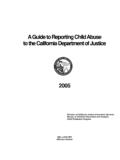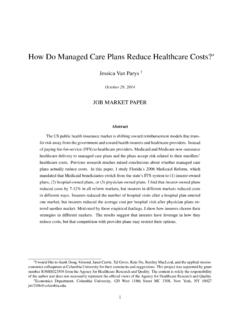Transcription of CALIFORNIA’S CLOSED HOSPITALS, 1995-2000
1 NICHOLAS C. PETRIS CENTER. ON health care MARKETS AND CONSUMER WELFARE. UNIVERSITY OF california , BERKELEY. SCHOOL OF PUBLIC health . california 'S CLOSED HOSPITALS, 1995 -2000. JANUARY 2001, REVISED APRIL 2001. Nicholas C. Petris Center on health care Markets and Consumer Welfare University of california , Berkeley School of Public health 2150 Shattuck, Suite 525. Berkeley, CA 94720. (510) 643-4100 phone/ 643-4281 fax Director, Richard Scheffler, PhD. Mission Statement The Center will help to guide public policy by creating the data and conducting the research needed to understand today's complex health care market. It will provide up to date information on changes in the health care system that may impact the health care marketplace and alter its capacity to provide high- quality care at competitive prices. It will assess issues related to the welfare of california consumers, especially affordability, availability and access to health care with a particular focus on low and moderate- income consumers.
2 It will concern itself with the role of consumer choice and the participation of front- line workers in the health care delivery system. The Center will conduct studies and provide objective information to lawmakers, regulators, consumer-advocates, health care providers and the public at large. Petris Center Advisory Committee Tangerine Brigham, MPP Paul Feldstein, PhD. Director of Policy and Planning Professor, School of Business San Francisco Department of Public health University of california , Irvine Kathleen Foote Frech III, PhD. Supervising Deputy Attorney General Professor of Economics Antitrust Section University of california , california Department of Justice Santa Barbara Deborah Haas-Wilson, PhD Sherry Hirota Professor of Economics Executive Director Smith College Asian health Services Patrick Johnston Ted Keeler, PhD.
3 Former california State Senator Professor of Economics Stockton University of california , Berkeley Eliseo Medina William Powers Executive Vice President, Western Region Legislative Director Service Employees International Union Congress of california Seniors Lourdes Rivera, PhD, JD Harry Snyder, JD. Staff Attorney Senior Advocate National health Law Program Consumers Union David Werdegar, MD, MPH Valerie Wilk Former Director Public Policy Analyst Office of Statewide health American Federation of State, Planning and Development County and Municipal Employees Bill Lockyer (ex-officio member) Edward Penhoet, PhD (ex-officio member). Attorney General Dean, School of Public health State of california University of california , Berkeley california 'S CLOSED HOSPITALS, 1995 -2000. A Project of the Nicholas C. Petris Center on health care Markets and Consumer Welfare University of california , Berkeley, School of Public health hospital Closure Project Staff: Rachael Kagan, MA; Lisa Simonson Maiuro, PhD; Julie Schmittdiel, MA; Wil Yu1.
4 BIOGRAPHIES. Richard Scheffler, PhD is the Distinguished Professor of health Economics and Public Policy at the University of california , Berkeley, School of Public health and Goldman School of Public Policy. He teaches health economics, international health economics and the economics of medicine and managed care . His research areas include healthcare markets and workforce, health insurance, mental health economics and health system reforms in Western and Eastern Europe. Scheffler serves as Director of the Petris Center. Rachael Kagan, MA is a healthcare policy and business writer who previously covered regional healthcare for the Oakland Tribune and the ANG Newspaper Group. She has written about healthcare antitrust, managed care , the uninsured, medical education and medical ethics. Her work has appeared in Ms. Magazine, The Nation, NurseWeek and Modern Physician magazines.
5 Kagan earned a master's degree in journalism from Syracuse University and a bachelor's in history from Macalester College. She is the Petris Center's Publications Director. Lisa Simonson Maiuro, PhD is a former Deputy Director of the Office of Statewide health Planning and Development, health Planning and Policy Division. Her work has focused on directing applied health policy research in a managed care environment, healthcare antitrust and statistical analysis. She has served as a consultant in antitrust matters for the Federal Trade Commission and the california Attorney General and acted as an expert witness for the Department of Justice. Maiuro earned her PhD from UCLA/RAND Center for health Policy Studies. She now works as an independent consultant, providing healthcare financial and market analysis. Julie Schmittdiel, MA received her bachelor's degree in Mathematics from the Massachusetts Institute of Technology, and her master's degree in Biostatistics from University of california , Berkeley.
6 She has previously worked as a consultant at Kaiser Permanente Northern california 's Division of Research, where her research interests included differences in primary care delivery by physician specialty and gender, and the impact of patient choice on satisfaction. She is a pre- doctoral trainee with the Agency for Healthcare Research and Quality, currently pursuing her PhD in health Services and Policy Analysis from the University of california , Berkeley. Wil Yu received his bachelor's degree in Cognitive Science from the University of california , Berkeley. He served as Research Associate at the Petris Center until January 2001. Currently, he is a Project Manager for the health Technology Center in San Francisco, where he directs research on current and future health technologies. He will receive a master's in public health from the University of california , Berkeley, in May 2001.
7 1. Wendy Dyer, MS, joined the Petris Center as Staff Research Associate in March 2001. She assisted in creating the revisions to the final version of this report. FINAL REPORT. CONTENTS. Executive Summary ..1. Map: CLOSED Hospitals in the State of california Introduction and Methodology ..3. Findings ..6. Distribution and Characteristics of CLOSED Hospitals .. 6. Table 1: Year of Closure for CLOSED General Acute care Hospitals, 1995 -2000. Figure 2: Licensed Beds of CLOSED Hospitals Compared to Licensed Beds of General Acute care Hospitals in 1999. Figure 3: Distribution of CLOSED Hospitals by Licensed Beds Figure 4: CLOSED General Acute care Hospitals, 1995 -2000, by Ownership Figure 5: CLOSED Hospitals by Ownership Compared to All General Acute care Hospitals in 1996 and 1999. Figure 6: Proportion of Revenues and Discharges from Medicare and MediCal for CLOSED Hospitals Figure 7: Average Proportion of Revenue and Discharges from MediCal.
8 Comparison of CLOSED Hospitals Figure 8: Average Proportion of Revenue and Discharges from Medicare . Comparison of CLOSED Hospitals Reasons for Closure 11. Figure 9: Net Patient Revenue per Bed for CLOSED Hospitals Figure 10: Net Income per Bed for CLOSED Hospitals Figure 11: Patient Days for CLOSED Hospitals: 1, 2 & 3 Years Prior to Closure Public Reaction ..15. Current Use of hospital Buildings and Land .16. Impact and Location of Other Nearby Hospitals 17. Maps: CLOSED Hospitals in Los Angeles, San Diego, Central california , Northern california , Tulare and Santa Maria Conclusion and Areas for Further Study . 18. Appendices .21. Appendix A: CLOSED Hospitals and Financial Performance Appendix B: Chart of Hospitals Excluded from Study Appendix C: Chart of california 's CLOSED Hospitals, 1995 -2000. FINAL REPORT. EXECUTIVE SUMMARY.
9 The Petris Center on health care Markets and Consumer Welfare studied short- term general acute care hospitals that CLOSED in california during the years 1995 to 2000. We identified 23 closures, 11 of which took place at for-profit facilities. The vast majority took place in urban areas, and they were most often in southern california . More than half of the CLOSED hospitals had fewer than 100 licensed beds. Ten of the CLOSED hospitals had changed ownership within three years prior to their closure. All the CLOSED hospitals claimed, and demonstrated, financial distress prior to closing. To create this report, we first set out to document and verify the closures. We then described the CLOSED hospitals, in terms of tax status, location, bed size and other factors. We analyzed the financial status of the group of CLOSED hospitals in the three years prior to closing.
10 We looked for public reactions or objections to the closure, as best we could find them from press reports and other public information. We further assessed what happened to the vacant facilities, and the location of other nearby hospitals. Using this information, we then were able to draw some overall conclusions about california 's CLOSED hospitals. Highlights of our findings are presented in the bullet points below. A. complete report of the project follows. *23 california general acute care (GAC) hospitals CLOSED between 1995 and 2000. *The largest proportion of those that CLOSED , 11 hospitals or 48 percent, were for-profit enterprises. Statewide, however, for-profits made up less than a third of hospitals in both 1996. and 1999. *Only four of the hospitals CLOSED were in rural areas. *The Los Angeles area experienced the greatest number of closures: 11 hospitals.


















